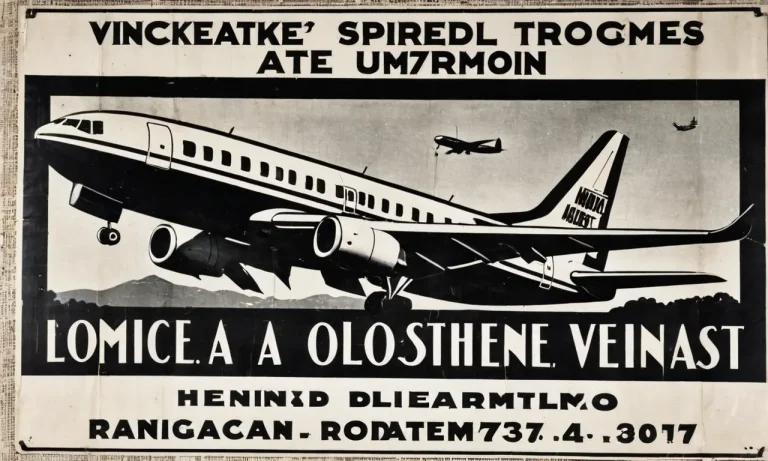Boeing 767 Vs Boeing 787: How Do These Popular Aircraft Compare?
When it comes to popular wide-body aircraft, the Boeing 767 and 787 are two models that often come to mind. As twin-engine airliners known for their fuel efficiency and range capabilities, they serve key roles for many leading airlines around the world.
If you’re short on time, here’s a quick answer: While the older 767 offers proven reliability at a lower price point, the high-tech carbon composite 787 brings breakthrough fuel economy and passenger comforts to mid-size long haul routes.
In this comprehensive comparison guide, we’ll analyze how these two Boeing aircraft match up across categories like design and technology, cabin features, operating costs, variants, airline adoption and more.
By the end, you’ll understand the key similarities and differences that matter most to airlines and passengers.
Aircraft Design and Technology
Materials and Construction
Both the Boeing 767 and Boeing 787 are constructed using advanced materials that make them lighter and more fuel-efficient compared to older aircraft models. However, there are some differences in the materials used.
The Boeing 767 primarily utilizes aluminum in its construction, which has been a widely used material in the aviation industry for many years. On the other hand, the Boeing 787 incorporates a higher percentage of composite materials, such as carbon fiber-reinforced polymer, making it significantly lighter and more resistant to corrosion.
According to Boeing, the use of composites in the 787’s construction contributes to its improved fuel efficiency and overall performance. These materials also allow for a more spacious cabin with larger windows, enhancing the passenger experience.
Engines
The engines of an aircraft play a vital role in determining its performance and fuel efficiency. When comparing the Boeing 767 and Boeing 787, there are notable differences in engine technology.
The Boeing 767 typically features engines from manufacturers such as General Electric and Pratt & Whitney, which are known for their reliability and durability. These engines provide sufficient power for the aircraft’s operations.
On the other hand, the Boeing 787 is equipped with more advanced engines, such as the Rolls-Royce Trent 1000 and General Electric GEnx. These engines incorporate innovative technologies, including quieter operation and better fuel efficiency, resulting in reduced emissions and operating costs.
According to Boeing, the engines used in the 787 are designed to provide better performance at higher altitudes, allowing the aircraft to operate efficiently on long-haul routes.
Aerodynamics and Efficiency
Both the Boeing 767 and Boeing 787 are designed with aerodynamic principles in mind, aiming to reduce drag and improve fuel efficiency.
However, the Boeing 787 takes aerodynamics to the next level with its sleeker design and advanced wing technology. The aircraft features raked wingtips, which reduce vortex drag and improve fuel efficiency by minimizing turbulent airflow at the wingtips.
Furthermore, the Boeing 787 incorporates a more efficient airframe design, including smoother contours and blended winglets, which further enhance its aerodynamic performance.
According to Boeing, these aerodynamic improvements result in a significant reduction in fuel consumption compared to older aircraft models like the Boeing 767.
Aircraft Variants
Boeing is a well-known name in the aviation industry, and two of their most popular aircraft models are the Boeing 767 and the Boeing 787. Let’s take a closer look at these aircraft variants and compare their key features.
Boeing 767
The Boeing 767 is a long-range, wide-body twinjet aircraft that was first introduced in the early 1980s. It was designed to be a replacement for the aging Boeing 707 and Boeing 727 models. The 767 has been widely used by airlines around the world for both passenger and cargo operations.
Key features of the Boeing 767 include:
- Capacity: The Boeing 767 can typically seat between 181 and 375 passengers, depending on the variant and configuration.
- Range: It has a range of approximately 6,000 to 7,000 nautical miles, depending on the model.
- Efficiency: The 767 is known for its fuel efficiency, making it an attractive option for airlines looking to reduce operating costs.
- Reliability: This aircraft has a strong track record of reliability and has been in service for several decades.
Boeing 787
The Boeing 787, also known as the Dreamliner, is a more recent addition to Boeing’s lineup and was first introduced in 2011. It is a long-range, wide-body twinjet that incorporates several advanced technologies to enhance performance and passenger comfort.
Key features of the Boeing 787 include:
- Capacity: The Boeing 787 can typically seat between 242 and 330 passengers, depending on the variant and configuration.
- Range: It has a range of approximately 7,530 to 8,000 nautical miles, depending on the model.
- Efficiency: The 787 is designed to be highly fuel-efficient, thanks to its lightweight composite materials and advanced engines.
- Comfort: Passengers on the Dreamliner can enjoy larger windows, improved cabin pressurization, and reduced noise levels for a more pleasant flying experience.
Comparison
When comparing the Boeing 767 and the Boeing 787, several factors come into play. The 787 offers a longer range and higher passenger capacity compared to the 767. It is also more fuel-efficient and incorporates advanced technologies for enhanced passenger comfort.
However, the 767 has a proven track record of reliability and has been widely used by airlines for several decades.
Ultimately, the choice between the two aircraft variants depends on the specific needs and priorities of the airline. Some airlines may opt for the 767 for its reliability and lower operating costs, while others may prefer the 787 for its advanced features and higher passenger capacity.
For more information on the Boeing 767 and Boeing 787, you can visit the official Boeing website at www.boeing.com.
Cabin Layout and Passenger Experience
Seating Capacity
When it comes to seating capacity, the Boeing 767 and Boeing 787 differ slightly. The Boeing 767 typically has a seating capacity of around 181 to 375 passengers, depending on the variant and airline configuration. On the other hand, the Boeing 787 can accommodate approximately 242 to 330 passengers.
It’s important to note that these seating capacities can vary based on factors such as the specific airline’s layout and seating arrangements. Some airlines may choose to configure their aircraft with more spacious seating, which can result in a lower overall seating capacity.
Cabin Amenities and Comforts
Both the Boeing 767 and Boeing 787 offer a range of amenities and comforts to enhance the passenger experience during flights.
The Boeing 767 typically features larger overhead bins, allowing passengers to stow their carry-on luggage more easily. Additionally, many Boeing 767s offer in-flight entertainment systems, providing passengers with a variety of movies, TV shows, and music to enjoy during their journey.
The Boeing 787 takes passenger comfort to the next level with its innovative design and features. The cabin of the Boeing 787 is equipped with larger windows, allowing for more natural light and better views.
Moreover, the aircraft is designed to have a quieter cabin, reducing noise levels and creating a more peaceful environment for passengers.
Furthermore, the Boeing 787 is equipped with higher humidity levels and improved air quality, which can contribute to a more comfortable and enjoyable flying experience. The aircraft’s advanced lighting system is designed to simulate natural light, helping to reduce jet lag and create a more pleasant ambiance onboard.
It’s worth mentioning that specific amenities and comforts can vary depending on the airline and their chosen configuration. Some airlines may opt for additional features such as lie-flat seats, premium cabin options, or even onboard Wi-Fi connectivity.
Overall, both the Boeing 767 and Boeing 787 offer a comfortable and enjoyable passenger experience. While the Boeing 767 provides a reliable and spacious cabin, the Boeing 787 takes it a step further with its innovative design and enhanced features.
Whether you’re flying on a Boeing 767 or a Boeing 787, you can expect a great experience onboard.
Flight Range and Performance
When it comes to flight range and performance, both the Boeing 767 and Boeing 787 are impressive aircraft. However, there are some key differences that set them apart.
Boeing 767:
The Boeing 767 has been a workhorse in the aviation industry for decades. It is known for its versatility and ability to fly long-haul routes. The range of the Boeing 767 varies depending on the model, but it can typically fly up to 6,385 nautical miles.
This makes it a great choice for airlines operating transatlantic or transpacific flights.
Additionally, the Boeing 767 is equipped with powerful engines that provide excellent performance. It has a cruising speed of around Mach 0.8, allowing it to cover long distances efficiently. The aircraft’s design also contributes to its performance, with features such as winglets that reduce drag and enhance fuel efficiency.
Boeing 787:
The Boeing 787, also known as the Dreamliner, is a newer aircraft that offers advanced technology and improved performance compared to the Boeing 767. One of its key advantages is its increased flight range.
The Boeing 787 can fly up to 7,530 nautical miles, surpassing the capabilities of the Boeing 767.
This extended range is made possible by the innovative use of lightweight composite materials in the construction of the Boeing 787, reducing its overall weight and increasing fuel efficiency. The aircraft’s fuel-efficient engines also contribute to its impressive flight range.
Comparison:
| Boeing 767 | Boeing 787 | |
|---|---|---|
| Flight Range | Up to 6,385 nautical miles | Up to 7,530 nautical miles |
| Cruising Speed | Approx. Mach 0.8 | Approx. Mach 0.85 |
For more information on the Boeing 767 and Boeing 787, you can visit www.boeing.com for detailed specifications and technical data.
Operating Costs
Fuel Efficiency
When comparing the Boeing 767 and the Boeing 787, one of the key factors to consider is fuel efficiency. The Boeing 787, also known as the Dreamliner, has been designed with advanced aerodynamics and the use of lightweight composite materials, making it more fuel-efficient than the Boeing 767.
According to Boeing, the Dreamliner is up to 20% more fuel-efficient compared to similar-sized planes, resulting in significant cost savings for airlines. This fuel efficiency is achieved through features such as the use of more efficient engines and improved wing design, allowing the aircraft to consume less fuel while maintaining its performance.
Maintenance
Another aspect to consider when comparing the operating costs of the Boeing 767 and the Boeing 787 is maintenance. The Boeing 787 incorporates advanced technology and systems that require less frequent maintenance compared to the Boeing 767.
For example, the Dreamliner utilizes an advanced health management system that constantly monitors the aircraft’s systems and alerts maintenance crews to any potential issues before they become major problems.
This proactive approach to maintenance helps to reduce downtime and maintenance costs for airlines operating the Boeing 787.
Pilot Training
Pilot training is also a consideration when comparing the operating costs of these two aircraft. The Boeing 767 and the Boeing 787 have different cockpit designs and systems, which require pilots to undergo specific training to operate each aircraft.
While the Boeing 767 has been in service for many years and has a large pool of experienced pilots, the introduction of the Boeing 787 required additional training for pilots transitioning from the older model.
This additional training can result in increased costs for airlines in terms of training programs and simulator sessions.
Sources:
– Boeing. “Boeing 787 Dreamliner: Efficiency and Performance.” https://www.boeing.com/commercial/787/index.page
Airline Adoption and Routes
Both the Boeing 767 and the Boeing 787 have been widely adopted by airlines around the world. However, the Boeing 787, also known as the Dreamliner, has gained significant popularity since its introduction in 2011.
Its advanced technology and fuel efficiency have made it an attractive choice for airlines looking to expand their long-haul routes.
Airline Adoption:
Many major airlines, such as American Airlines, United Airlines, and British Airways, have incorporated the Boeing 787 into their fleet. Its versatility allows it to serve both domestic and international routes, making it a favorite among airlines seeking to optimize their operations.
On the other hand, the Boeing 767, which has been in service since the 1980s, is still utilized by several airlines, albeit to a lesser extent. It is commonly used for shorter-haul flights and as a freighter aircraft.
Routes:
The Boeing 787’s long-range capabilities have opened up new routes for airlines, connecting distant cities and enabling non-stop flights on previously underserved routes. For example, Qantas operates a non-stop service between Perth, Australia, and London, UK, using the Boeing 787-9, covering a distance of approximately 9,000 miles.
The Boeing 767, with its shorter range, is more commonly found on regional and domestic routes. It is often utilized for flights within continents, such as flights between major cities in Europe or North America.
It’s important to note that airline adoption and routes can vary depending on the specific needs and strategies of each airline. Some airlines may opt for a mix of both aircraft, utilizing the Boeing 787 for long-haul routes and the Boeing 767 for shorter distances.
For more information on airline routes and schedules, you can visit www.flightstats.com or www.kayak.com for real-time flight information.
Conclusion
In closing, both the 767 and 787 play important roles for airlines in the 200 to 300 seat mid-widebody segment. While the 767 offers reliability and lower ownership costs on many regional international routes, the 787 brings unprecedented levels of fuel economy and passenger comfort that allow new long haul routes to become economically viable.
Ultimately airlines must weigh their own network needs, cost structures and service priorities. But passengers worldwide continue benefitting from the technology and capabilities Boeing packs into these workhorse widebody twins that connect global travelers.








